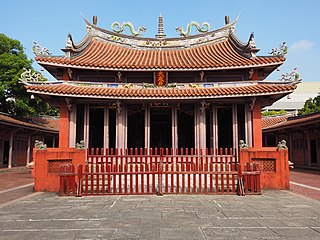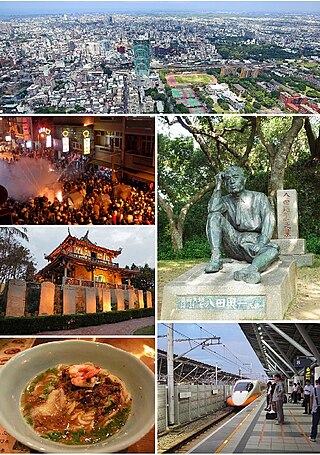Tu Cheng-sheng | |
|---|---|
杜正勝 | |
 Minister Tu in 2007 | |
| 22nd Minister of Education of the Republic of China | |
| In office 20 May 2004 –20 May 2008 |
Related Research Articles

The Penghu or Pescadores Islands are an archipelago of 90 islands and islets in the Taiwan Strait, located approximately 50 km (31 mi) west of the main island of Taiwan across the Penghu Channel, covering an area of 141 square kilometers (54 sq mi). The archipelago collectively forms Penghu County of Taiwan and is the smallest county of Taiwan. The largest city is Magong, located on the largest island, which is also named Magong.

The music of Taiwan reflects the diverse culture of Taiwanese people. Taiwan has undergone several economic, social, and political changes through its cultural history, and Taiwanese music reflects those issues in its way. The music of the country has adopted a mixed style. As a country rich in Chinese folk culture and with many indigenous tribes with their own distinct artistic identity, various folk music styles are appreciated in Taiwan. In addition, people in Taiwan highly appreciate various style of Western classical music and pop music. Taiwan is a major Mandopop hub.

Anping District is a district of Tainan, Taiwan. In March 2012, it was named one of the Top 10 Small Tourist Towns by the Tourism Bureau of Taiwan. It is home to 64,408 people according to the 2020 census.

The Sinkang Manuscripts are a series of leases, mortgages, and other commerce contracts written in the Sinckan, Taivoan, and Makatao languages. Among Han Chinese, they are commonly referred to as the "barbarian contracts". Some are written only in a Latin-based script, considered the first script to be developed in Taiwan itself, while others were bilingual with adjacent Han writing. Currently there are approximately 140 extant documents written in Sinckan; they are important in the study of Siraya and Taivoan culture, and Taiwanese history in general although there are only a few scholars who can understand them.

Chung Chao-cheng was a Taiwanese novelist and Hakka native born in the Hsinchu Prefecture during the Japanese rule period. Revered as the "Mother of Taiwanese Literature" in Taiwan, he is also frequently mentioned alongside Taiwanese writer Yeh Shih-tao, collectively known as "North Chung, South Yeh".

Huwei Township is an urban township in Yunlin County, Taiwan. It has a population of about 70,300.
San zhi xiao zhu is the Mandarin Chinese pronunciation of the Chinese language name for the popular folk-tale The Three Little Pigs. In late 2005, the Ministry of Education in Taiwan listed the phrase in an appendix to its online chengyu (idiom) dictionary; media reports on the listing surfaced in Taiwan and later Hong Kong in late January 2007, generating a controversy over the definition of chengyu in which academics and members of the public criticised the Ministry of Education.

The Tainan Confucian Temple or Quan Tai Shou Xue, is a Confucian temple on Nanmen Road (南門路) in West Central District, Tainan, Taiwan.

Han Pao-teh was a Taiwanese architect, educator, scholar, writer, museum curator and calligrapher.

Tainan, officially Tainan City, is a special municipality in southern Taiwan facing the Taiwan Strait on its western coast. Tainan is the oldest city on the island and commonly called the "prefectural capital" for its over 260 years of history as the capital of Taiwan under the Dutch rule, the Kingdom of Tungning and later Qing dynasty rule until 1887. Tainan's complex history of comebacks, redefinitions and renewals inspired its popular nickname "the Phoenix City". Tainan is classified as a "Sufficiency"-level global city by the Globalization and World Cities Research Network.

The National University of Tainan is a university in West Central District, Tainan, Taiwan.

Sheng-Ching Chang is a Taiwanese art historian. She serves as the director of the Graduate Institute of Museum Studies at Fu Jen Catholic University and the professor at the Department of History of Fu Jen Catholic University in Taipei.
Philosophy in Taiwan is the set of philosophical traditions in Taiwan, while Taiwanese philosophy is taken to mean philosophical work from the country. Philosophical thought in Taiwan is diverse, drawing influence from Chinese philosophy during Qing rule from the 17th and 18th century, and Western philosophy through the Kyoto School during Japanese rule in the 19th and early 20th century. Taiwanese philosophy took a more endogenous turn during the modern era, with burgeoning philosophical debate regarding Taiwanese Gemeinschaft.
Ho Chen Tsu(賀陳詞)(1918-1994), born in Hengyang, Hunan Province, is one of the first generation of architects and important architecture educators in post-war Taiwan.
Tang Shui Liu, biologist, botanist, and forestry researcher. Born in Anfu County, Jiangxi, China, in 1910, he passed away in Los Angeles, United States in 1997. Liu made significant contribution through his extensive publications, and he is one of the editors for the inaugural edition of Flora of Taiwan.
The Zuojhen Man is a human fossil. Scholars named it the “Zuojhen Man” due to its being discovered in Tsai-Liao Creek in Zuojhen District,Tainan City. Fossils of Zuojhen Man were once determined to be approximately 20,000 to 30,000 years old, earning it the title of being “Taiwan’s most ancient man.” In a reexamination in 2015, the fossil was determined to be from the late Neolithic period, 3,000 years ago.

The National Flag of Republic of Formosa was used as flag and emblem of the Republic of Formosa, which was founded in Taiwan and existed from May 23 to October in 1895. Due to its design of a blue ground and a yellow tiger, it was also called the Blue Ground Yellow Tiger Flag, or simply the Yellow Tiger Flag. On the same day the flag began its usage, Tang Jingsong (唐景崧) announced the “Declaration of Independence of the Republic of Formosa.”

Wang Chang-hsiung, originally named Wang Jung-sheng (王榮生), was a dentist and writer born in Tamsui District, New Taipei City, Taiwan. He gained recognition for his novella A Raging Torrent (奔流) published in 1943, which received diverse reviews due to its seemingly political nature and struggles with national identity.
References
- 1 2 "Nose-picking lawmaker to shout his last good-bye", Reuters, Apr 24, 2008
- ↑ Yates, Robin D. S. "The City-State in Ancient China"
- ↑ Museum, National Palace (2020-05-08). "Present/Former Leaders". National Palace Museum. Retrieved 2020-06-27.
| Tu Cheng-sheng | |||||||||||||||
|---|---|---|---|---|---|---|---|---|---|---|---|---|---|---|---|
| Traditional Chinese | 杜正勝 | ||||||||||||||
| |||||||||||||||